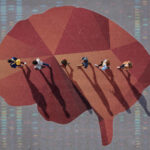Right now, high school seniors across the United States are making big decisions about where to apply to college and what kind of learning experience they want. For many families, this is a stressful yet exciting time filled with campus visits, application essays, and different options for the future. As parents and guardians, we entrust colleges and universities with the education of our young adults, often at great financial cost and emotional investment. We’re led to believe they’ll receive a world-class education, guided by expert educators who are preparing them for successful futures in a technology-driven world that increasingly relies on STEM — science, technology, engineering, and mathematics. But there’s a startling truth that many families don’t realize: Most professors, including those teaching critical STEM courses, have minimal, if any formal training in teaching, and universities know this when hiring them.
Most universities select faculty predominantly for their expertise and research potential, not necessarily for teaching abilities. And most professors receive little to no training in how to teach during graduate school. Even when teaching assistant training exists, it’s usually minimal and led by senior faculty who also lack formal pedagogical training. Consequently, teaching capacity is too often untested and unsupported. Once hired, faculty teaching performance is rarely scrutinized or rewarded. According to a 2023 article in The Chronicle of Higher Education, titled “Americans Value Good Teaching. Do Colleges?” only 26 percent of institutions have teaching centers, leaving many faculty without pedagogical support. This means most new professors start their teaching careers learning on the job — a concern highlighted in a 2018 Chronicle article titled “Who’s Teaching the Teachers?” which noted that effective teaching requires deliberate practice and mentorship, often absent in doctoral programs. As a result, new faculty are often underprepared for instructional roles, especially in demanding STEM fields where complex concepts require clear and effective teaching methods.
There are different approaches to teaching, and they matter significantly in terms of student learning and retention. Traditional lecturing involves delivering information in a one-way format, while active learning engages students through activities like discussions, problem-solving, and interactive questioning. A 2014 study in the Proceedings of the National Academy of Sciences found that active learning significantly improves exam performance in STEM courses, raising grades by about half a letter on average. Failure rates under traditional lecturing were 55 percent higher than with active learning methods — an alarming statistic when foundational knowledge is crucial for advanced learning in sciences and engineering. In a 2020 study following up on this work, researchers found that the intensity of active learning also mattered; only classes devoting substantial time to interactive techniques narrowed achievement gaps. Unfortunately, without training, many professors default to the lecture format they experienced during their education, missing opportunities to engage students more effectively and to inspire future scientists and engineers.
New faculty are often underprepared for instructional roles, especially in demanding STEM fields where complex concepts require clear and effective teaching methods.
The lack of pedagogical training can also exacerbate educational inequalities. Research indicates that traditional lectures disproportionately disadvantage underrepresented students. The 2020 study showed that inclusive teaching practices in STEM courses significantly shrink achievement gaps between underrepresented minority students and their peers. Without training, professors may be unaware of these disparities and how to address them, inadvertently hindering efforts to diversify STEM professions.
Teaching challenges became more apparent during the Covid-19 pandemic. The shift to online learning revealed many professors’ inability to adapt their teaching methods and engage students effectively. While some rose to the occasion, in our experience, many struggled, and students suffered. This has sparked conversations about the need for better teacher preparation in higher education, especially in STEM, where hands-on experience and interactive learning are crucial.
With the upcoming transition in the federal government, higher education faces significant threats, including potential funding cuts and reduced support for research. These shifts risk worsening the systemic lack of teaching preparation, particularly in STEM fields, leaving students less equipped for a technology-driven workforce.
When visiting campuses or talking to admissions officers, ask targeted questions about the institution’s commitment to teaching quality, especially in STEM departments.
What can be done? We can hope universities will prioritize teaching by supporting new faculty and recognizing excellent teaching in tenure decisions. However, institutional change can be slow, often favoring research over teaching. As parents, there are steps we can take now. When visiting campuses or talking to admissions officers, ask targeted questions about the institution’s commitment to teaching quality, especially in STEM departments. For example: Does the university offer formal teacher training for faculty, and what percentage participate? If there’s no formal training, how do faculty gain teaching skills? Are faculty evaluated on teaching by trained educators or simply by colleagues who may also lack teaching expertise? By asking these questions, you can assess whether teaching quality is valued and help push universities toward change.
The high cost of tuition makes it more important than ever to ensure students receive a high-quality education. In STEM fields, where the U.S. aims to maintain a competitive edge, effective teaching is essential. Knowledge without effective teaching is like a treasure locked away without a key. It’s time for universities to unlock that treasure by equipping professors with the tools to teach effectively. Our young people — and the future of science and technology — deserve nothing less.
Chad M. Topaz is a faculty member at Williams College and cofounder of the Institute for the Quantitative Study of Inclusion, Diversity, and Equity. He is finishing a book on social justice and data science, forthcoming from Princeton University Press. He can be found online at Bluesky.
Nathanial Brown is a faculty member at Penn State University and a speaker on equity in science education at venues such as TEDx and the Howard Hughes Medical Institute.











